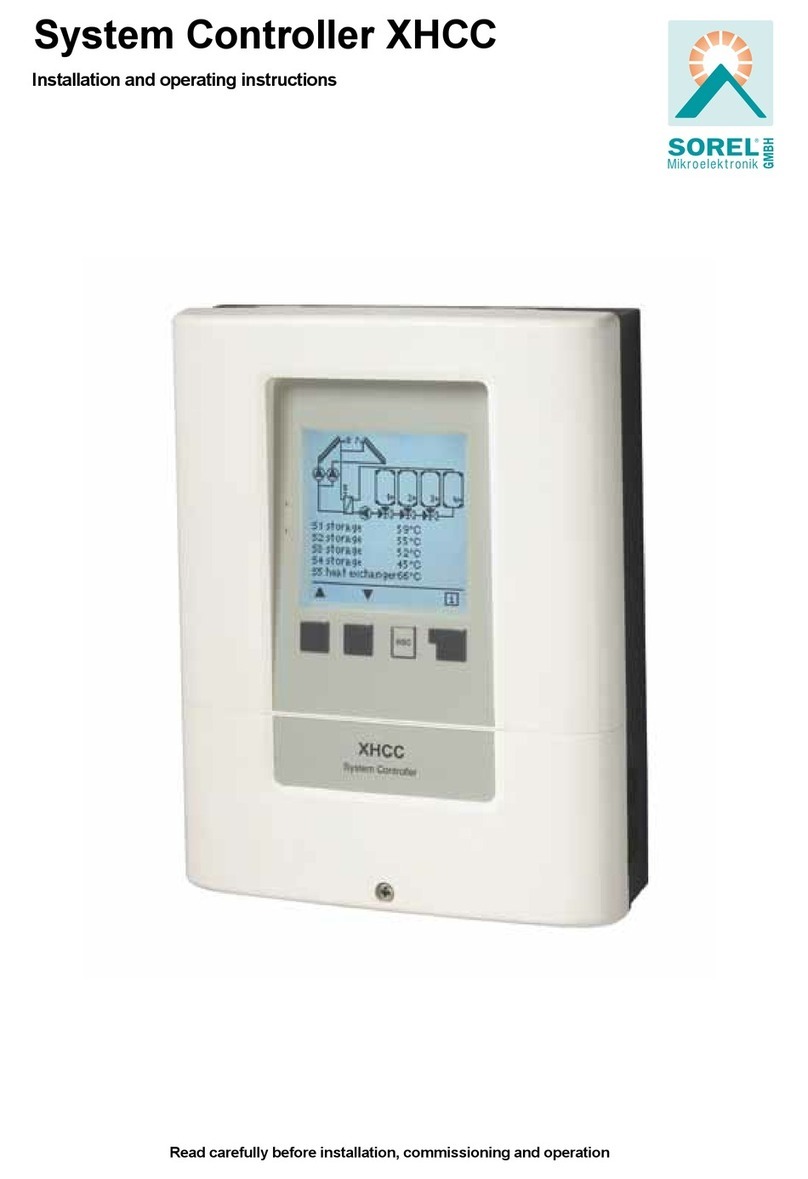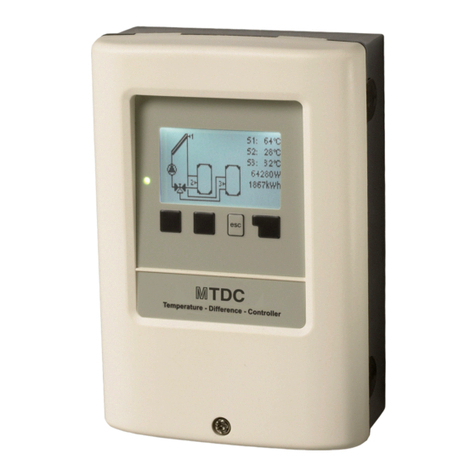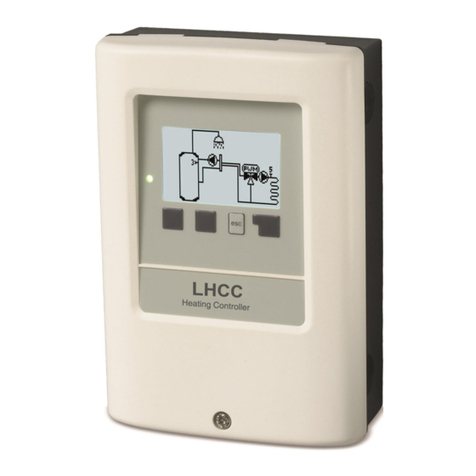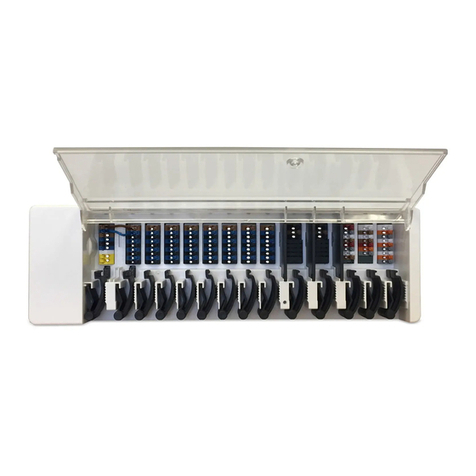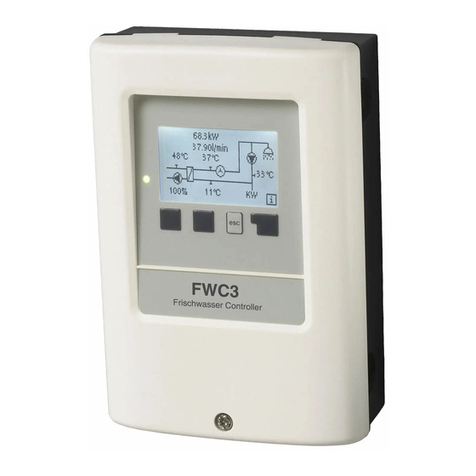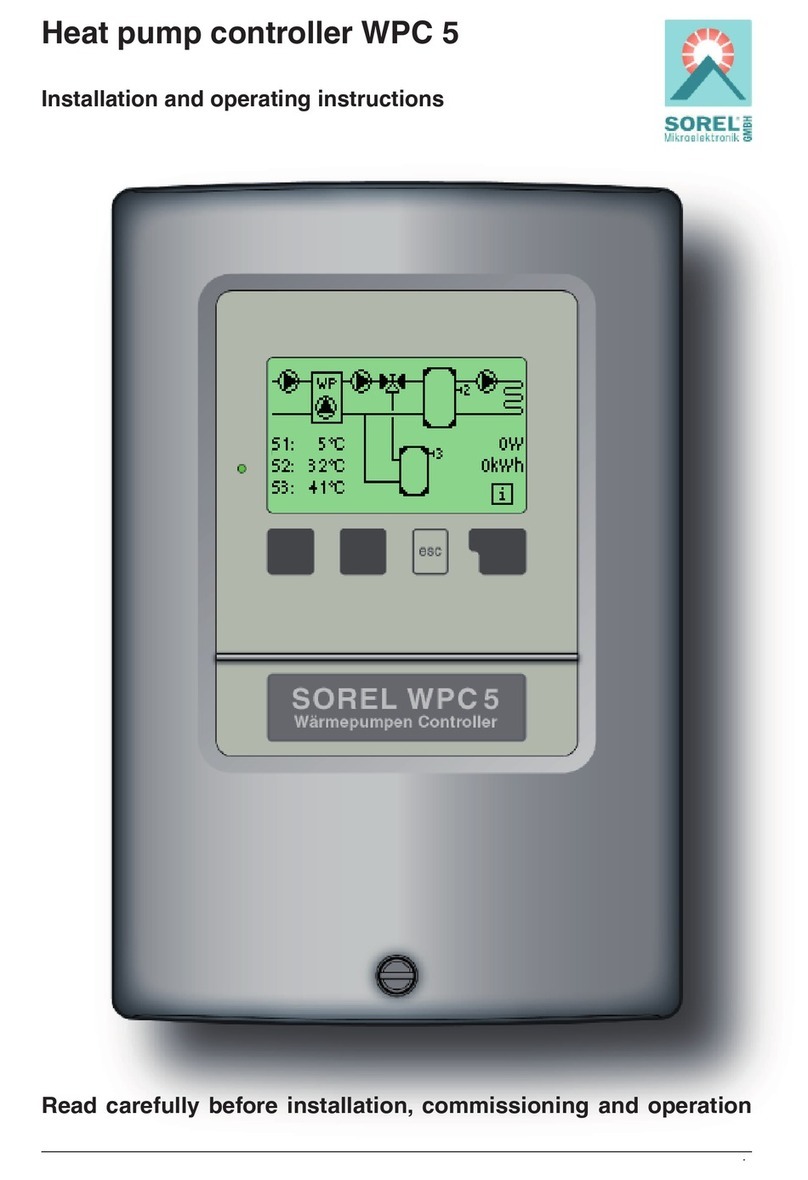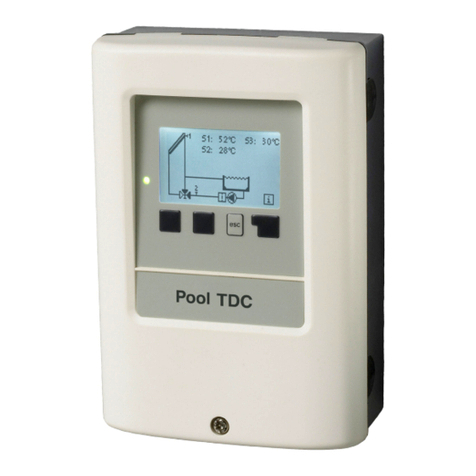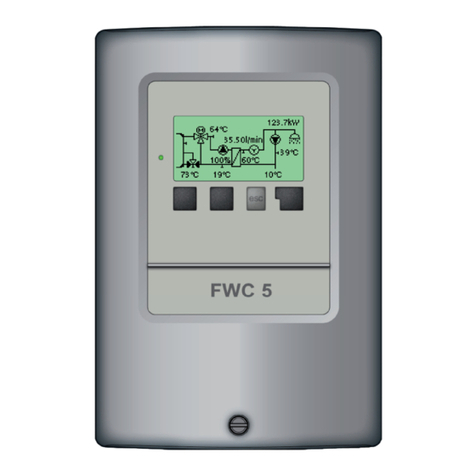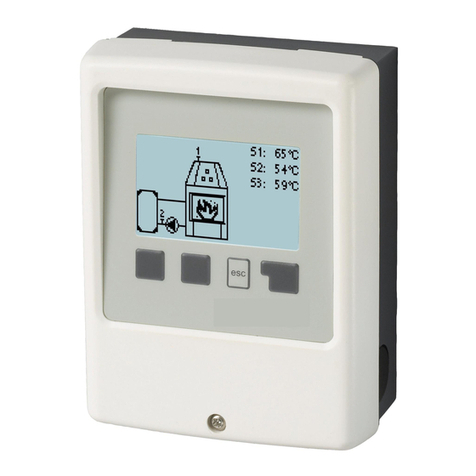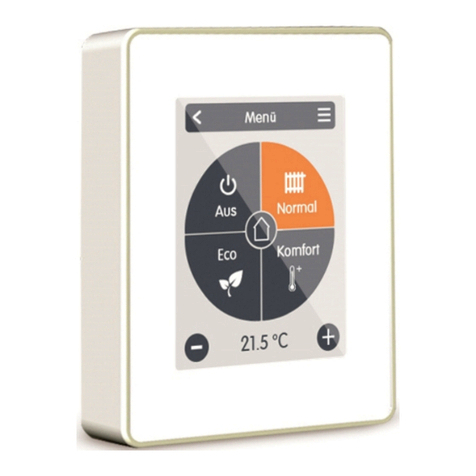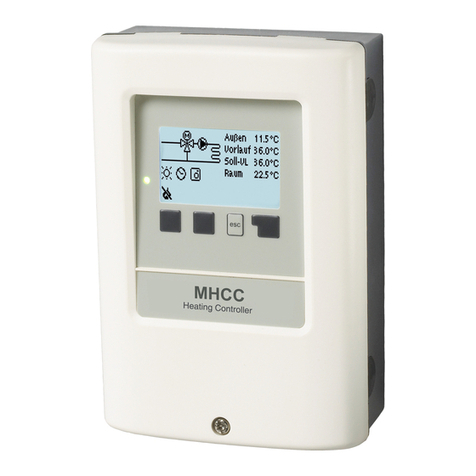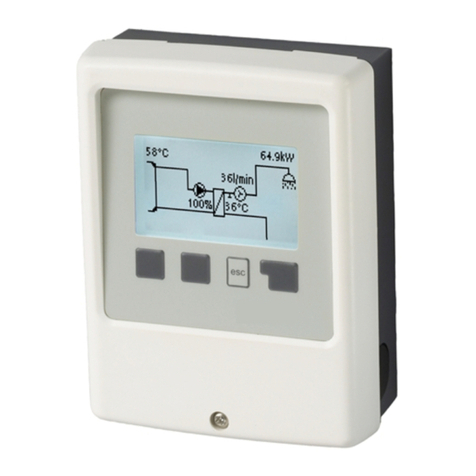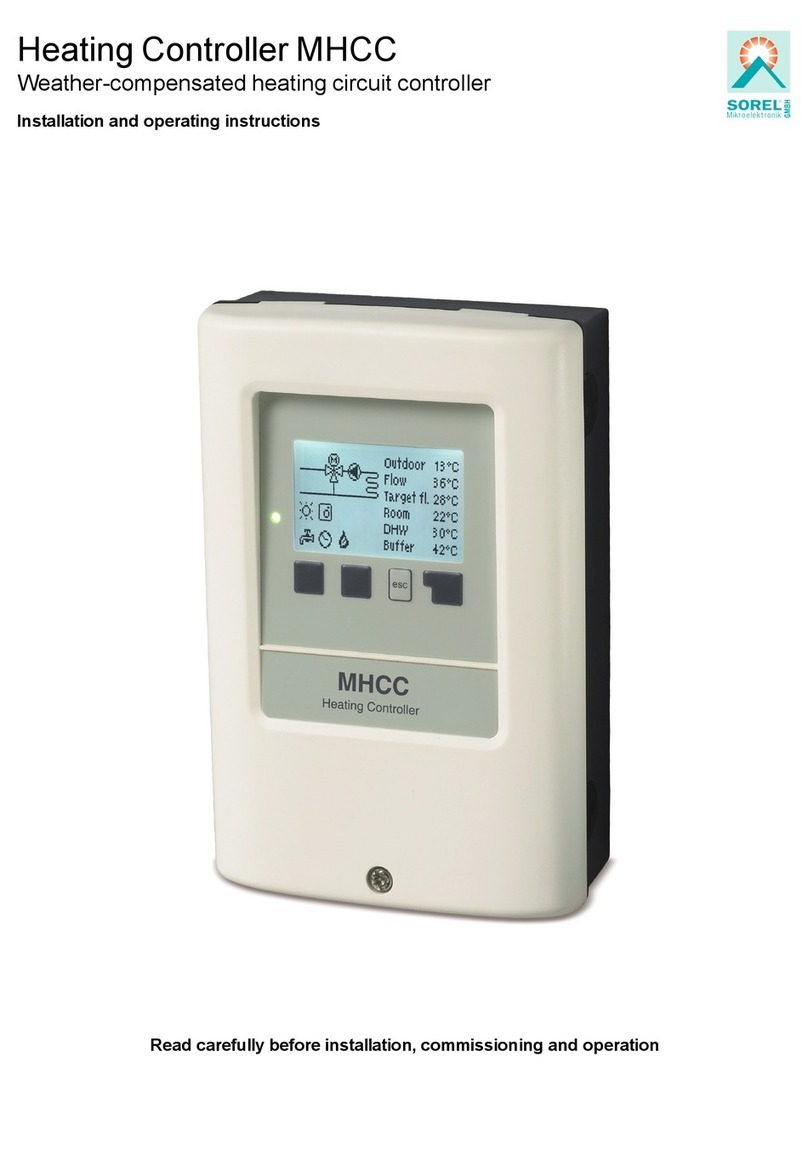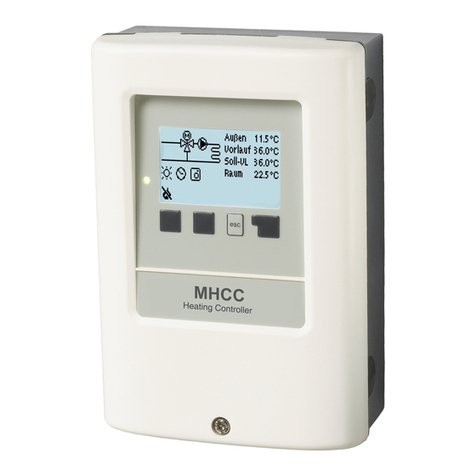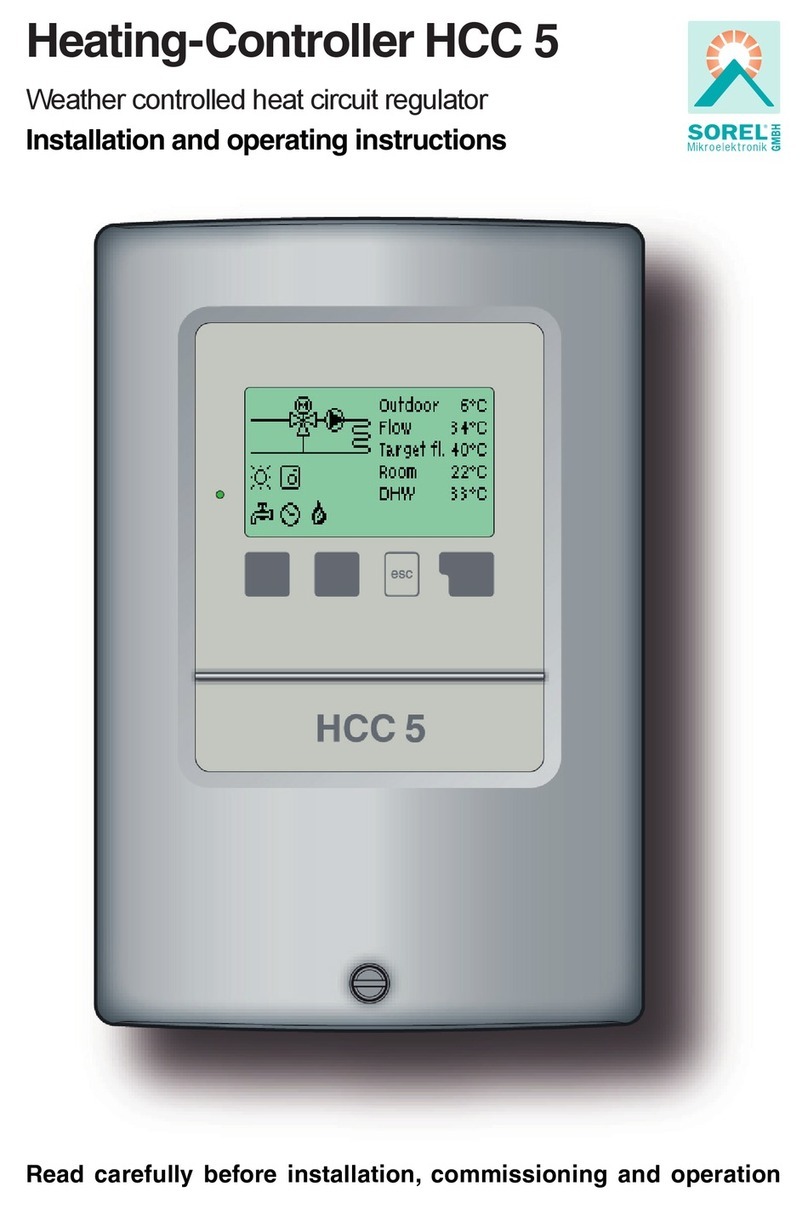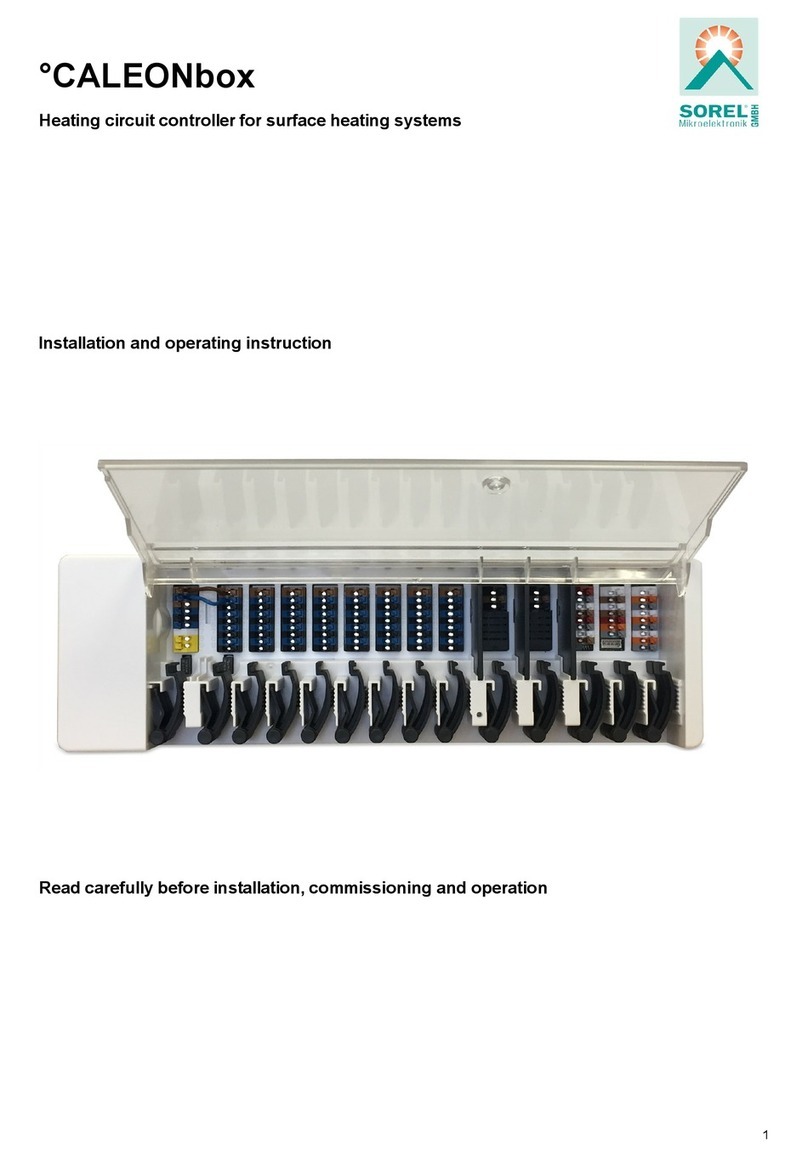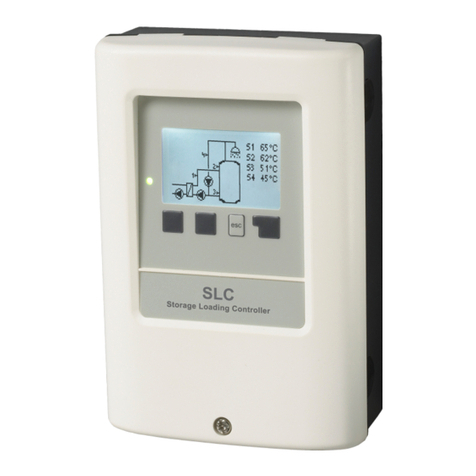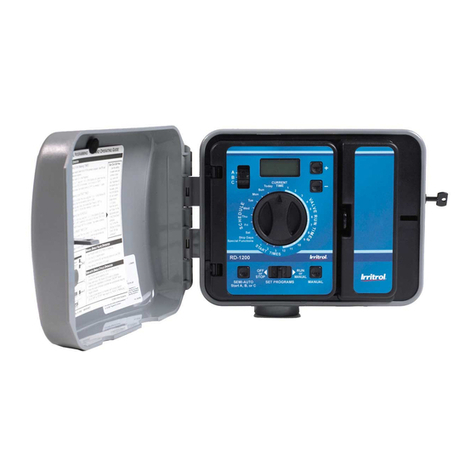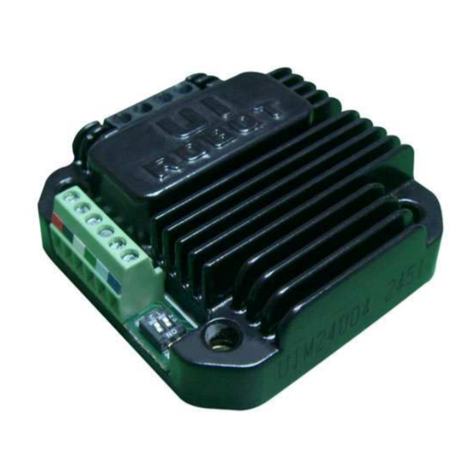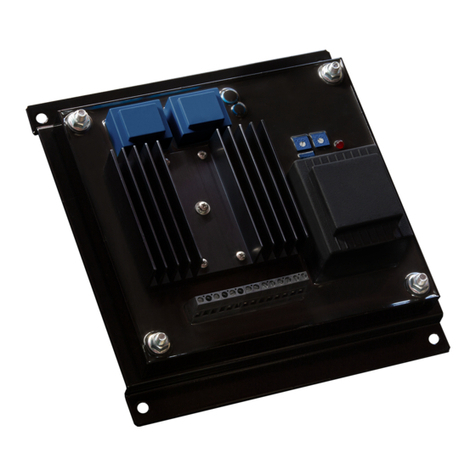Sorel HCC 6 User manual

Read carefully before installation, commissioning and operation
Heating-Controller HCC 6
Installation and operating instructions
Weather controlled heat circuit regulator
carefully before
i
i
ns
t
t
a
l
l
l
l
a
t
t
i
i
on comm
i
i
ss
i
i
on
i
i
ng and operation

Content
A.1. - EC declaration of conformity 3
A.2. - General instructions 3
A.3. - Explanation of symbols 3
A.4. - Changes to the unit 4
A.5. - Warranty and liability 4
B.1. - Specifications 5
B.2. - Temperature resistance table
for Pt1000 sensors 5
B.3. - About the controller 6
B.4. - Scope of supply 6
B.5. - Disposal and pollutants 6
B.6. - Hydraulic variants 7
C.1. - Wall installation 8
C.2. - Electrical connection 9
C.3. - Installing temperature sensors 10
C.4. - Electrical terminals 11
E.1. - Display and input 12
E.2. - Commissioning help 13
E.3. - Free commissioning 13
E.4. - Menu sequence and menu structure 14
1. - Measurements 15
2. - Statistics 16
2.1. - Today 16
2.2. - 28-days 16
2.3. - Operating hours Heat Circuit 16
2.4. - Operating hours Cooling 16
2.5. - Operating hours add. heating 16
2.6. - Error messages 16
2.7. - Reset / clear 16
3. - Times 17
3.1. - Time & Date 17
3.2. - Heating circuit day 17
3.3. - Heating Comfort 17
3.4. - Cooling times 17
4. - Operating modes 18
4.1. - Heating circuit 18
4.2. - Cooling 18
4.3. - Dehumidifier 19
4.4. - Manual 19
4.5. - Heat circuit reference 19
4.6. - 14 day reference 19
5. - Settings 20
5.1. - Heat circuit 20
5.1.1. - Su/Wi Day 20
5.1.2. - Su/Wi night 20
5.1.3. - Curve 21
5.1.4. - Day correction 22
5.1.5. - Night correction 22
5.1.6. - Comfort temperature boost 22
5.1.7. - Reference/actual - 22
5.1.8. - Reference/actual + 23
5.1.9. - Delay 23
5.1.10. - min. flow (heating) 23
5.1.11. - max. flow (heating) 23
5.2. - Settings cooling 24
5.2.1. - Cooling correction 24
5.2.2. - Off hysteresis 24
5.2.3. - On hysteresis 25
5.2.4. - Slope reference flow 25
5.2.5. - Room reference cooling 25
5.2.6. - Min. flow cool 25
5.2.7. - Max. flow cool 25
5.2.8. - Delay 25
5.2.9. - Cool storage 25
5.3. - Dehumidifier 26
5.3.1. - Reference humidity 26
5.4. - Manual humidity 26
5.5. - Room controller 27
5.5.1. - Influence room temperature 27
5.5.2. - Room ref. day 27
5.5.3. - Room ref. night 27
6. - Protective functions 28
6.1. - Anti-seizing 28
6.2. - Frost protection 28
7. - Special functions 29
7.1. - Sensor calibration 29
7.2. - Commissioning 29
7.3. - Factory settings 29
7.4. - Expansions 30
7.5. - Mixer 30
7.5.1. - Turn time 30
7.5.2. - Pause-Factor 30
7.5.3. - Increase 30
8. - Menu lock 31
9. - Service values 32
10. - Language 33
Z.1. Malfunctions with error messages 34
Z.2. Replacing the fuse 35
Z.3. Maintenance 35

3
Safety instructions
A.1. - EC declaration of conformity
By affixing the CE mark to the unit the manufacturer declares that the HCC 6 conforms to the
following relevant safety regulations:
- EC low voltage directive
73/23/EEC, as amended by 93/68/EEC
- EC electromagnetic compatibility directive
89/336/EEC version 92/31/EEC version 93/68/EEC
Conformity has been verified and the corresponding documentation and the EC declaration
of conformity are kept on file by the manufacturer.
Danger
Caution
A.2. - General instructions
These installation and operating instructions contain basic instructions and important
information regarding safety, installation, commissioning, maintenance and the optimal
use of the unit. Therefore these instructions must be read completely and understood
by the installation technician/ specialist and by the system user before installation,
commissioning and operation of the unit.
The valid accident prevention regulations, VDE regulations, the regulations of the lo-
cal power utility, the applicable DIN-EN standards and the installation and operating
instruction of the additional system components must also be observed. The controller
does not under any circumstances replace any safety devices to be provided by the
customer!
Installation, electrical connection, commissioning and maintenance of the unit may
only be carried out by specialists who possess the appropriate training. For the user:
Make sure that the specialist gives you detailed information on the function and opera-
tion of the controller. Always keep these instructions in the vicinity of the controller.
A.3. - Explanation of symbols
Failure to observe these instructions can result in danger to life from electric
voltage.
Danger
Failure to observe these instructions can result in serious damage to health
such as scalding, or even life-threatening injuries.
Caution
Failure to observe these instructions can result in destruction of the unit or the
system, or damage to the environment.
Information which is especially importation for the function and optimal use of
the unit and the system.
It is essential that you read this!

4
A.4. - Changes to the unit
A.5. - Warranty and liability
The controller has been manufactured and tested with regard to high quality
and safety requirements. The unit is subject to the statutory guarantee
period of two years from the date of sale.
The warranty and liability shall not include, however, any injury to persons or material
damage that is attributable to one or more of the following causes:
- Failure to observe these installation and operating instructions
- Improper installation, commissioning, maintenance and operation
- Improperly executed repairs
- Unauthorised structural changes to the unit
- Installation of additional components that have not been tested
together with the unit
- Any damage resulting from continued use of the unit despite an
obvious defect
- Failure to use original spare parts and accessories
- Use of the device for other than its intended purpose
- Operation above or below the limit values listed in the specifications
- Force majeure
- Changes, additions to or conversion of the unit are not permitted without
written permission from the manufacturer
- It is likewise forbidden to install additional components that have not
been tested together with the unit
- If it becomes clear that safe operation of the unit is no longer possible,
for example because of damage to the housing, then turn the controller
off immediately
- Any parts of the unit or accessories that are not in perfect condition must
be exchanged immediately
- Use only original spare parts and accessories from the manufacturer.
- Markings made on the unit at the factory must not be altered, removed
or made illegible
- Only the settings actually described in these instructions may be made
on the controller
Changes to the unit can compromise the safety and function of the unit
or the entire system.
Safety instructions
Danger

5
°C 0 102030405060708090100
Ω1000 1039 1077 1116 1155 1194 1232 1270 1308 1347 1385
Description of controller
B.1. - Specifications
2.1 Specifications:
Mains Voltage 230VAC +/- 10%
Mains frequency 50...60Hz
Power consumption 2VA
Total switched power 460VA (Relay outputs 1-3)
Switched power per relay 460VA for AC1 / 185W for AC3
Internal fuse 2A slow blow 250V
Protection category IP40
Protection class II
Sensor inputs 5x Pt1000 temperature sensor
1x humidity sensor
1x Remote adjuster
Measuring range -40 to 110°C
Permissible ambient conditions:
Ambient temperature
for controller operation 0°C...40°C
for transport/storage 0°C...60°C
Air humidity
for controller operation max. 85% humidity at 25°C
for transport/storage no moisture condensation permitted
Other specifications and dimensions
Housing design 2-part, ABS plastic
Installation methods Wall installation, optionally panel installation
Overall dimensions 163mm x 110mm x 52mm
Aperture installation dimensions 157mm x 106mm x 31mm
Display Fully graphical display 128 x 64 dots
Light diode Multicolour
Operation 4 entry keys
Temperature sensors: (may not be included in the scope of supply)
Immersion sensor Pt1000, e.g. immersion sensor TT/P4
Pipe-mounted sensor Pt1000, e.g. pipe-mounted sensor TR/P4
Outdoor sensor Pt1000, e.g. outdoor sensor TA52
Remote adjuster Pt1000, Typ RC22
Sensor leads 2x0.75mm² extendable up to 30m
B.2. - Temperature resistance table for Pt1000 sensors

6
B.3. - About the controller
The weather controlled Heat Circuit Controller HCC 6 facilitates efficient use and func-
tion control of your heating system. The device is impressive most of all for its function-
ality and simple, almost self-explanatory operation. For each step in the input process
the individual entry keys are assigned to appropriate functions and explained. The
controller menu contains headwords for the measured values and settings, as well as
help texts or clearly-structured graphics.
The HCC6 is a weather controlled Heating controller with heating request and for sys-
tems with one controlled heat circuit (=with mixer) and cooling function via air cooling
system.
Important characteristics of the HCC6:
- Depiction of graphics and texts in a lighted display
- Simple viewing of the current measurement values
- Statistics and monitoring of the system by means of statistical graphics, etc.
- Extensive setting menus with explanations
- Menu block can be activated to prevent unintentional setting changes
- Resetting to previously selected values or factory settings
- various additional functions are or will be available e.g. 0...10V connection for boiler control
B.4. - Scope of supply
- Heating controller HCC 6
- 3 screws 3,5x35mm and 3 plugs 6mm for wall installation
- 6 strain reliefs with 12 screws, replacement fuse 2AT
- installation and operating instructions HCC 6
Optionally contained depending on design/order:
- 1x outdoor sensor e.g. TA52 (Pt1000)
- 1-2x pipe-mounted sensor e.g. TR/P4 (Pt1000)
- 1x buffer sensor e.g. TT/P4 (Pt1000)
- 1x Indoor sensor/remote adjuster with mode switch RC22
- 1x Immersion sleeve e.g. TH150
- various additional functions expansion boards
Description of controller
B.5. - Disposal and pollutants
The unit conforms to the European RoHS directive 2002/95/EC for the restriction of
the use of certain hazardous substances in electrical and electronic equipment.
Caution
The unit must not under any circumstances be disposed of with ordinary
household refuse. Dispose of the unit only at appropriate collection
points or ship it back to the seller or manufacturer.

7
M
❄
Description of controller
B.6. - Hydraulic variants
Caution
The following illustrations should be viewed only as schematic dia-
grams showing the respective hydraulic systems, and do not claim to
be complete. The controller does not replace safety devices under any
circumstances. Depending on the specific application, additional system
components and safety components may be mandatory, such as check
valves, non-return valves, safety temperature limiters, scalding protec-
tors, etc., and must therefore be provided.

8
Caution
For panel installation, a
special installation set is
available as an accessory.
Installation
C.1. - Wall installation
1. Unscrew cover screw completely
2. Carefully pull upper part of housing
from lower part.
3. Set upper part of housing aside,
being sure not to touch the electronics
when doing so.
4. Hold the lower part of the housing
up to the selected position
and mark the 3 mounting holes.
Make sure that the wall surface
is as even as possible so that
the housing does not become
distorted when it is screwed on.
5. Using a drill and size 6 bit, drill 3
holes at the points marked on the
wall and push in the plugs.
6. Insert the upper screw and screw
it in slightly.
7. Fit the upper part of the housing
and insert the other two screws.
8. Align the housing and tighten the
three screws.
Caution
Install the controller only in dry areas and under the ambient conditions
described under B.1 „Specifications“. Carry out the following steps 1-8.
C.1.1.
C.1.2.

9
C.2. - Electrical connection
Before working on the unit, switch off the power supply and secure it
against being switched on again!
Check for the absence of power!
Electrical connections may only be made by a specialist and in compli-
ance with the applicable regulations. The controller may not be put into
operation if there is visible damage to the housing, e.g. cracks.
Caution
Danger
Low-voltage cables such as temperature sensor cables must be routed
separately from mains voltage cables. Feed temperature sensor cables
only into the left-hand side of the unit, and mains voltage cables only
into the right-hand side.
The cables being connected to the unit must not be stripped by more
than 55mm, and the cable jacket must reach into the housing just to the
other side of the strain relief.
The customer must provide an all-pole disconnecting device, e.g. a
heating emergency switch.
Caution
Caution
1.Open controller housing (see C.1)
2.Strip cables max. 55mm, insert, fit the
strain relief devices, strip the last 8-9 mm
of the wires. (Fig.C.2.1)
3. Open the terminals using a suitable
screwdriver (Fig. C.2.1) and make electrical
connections on the controller (Pages 11)
4. Refit upper part of housing and fasten with
screw.
6. Switch on mains voltage and place con-
troller in operation
Installation
C.2.1.

10
Installation
The temperature sensor cables must be routed separately from mains
voltage cables, and must not, for example, be routed in the same cable
duct!
The controller operates with Pt1000 temperature sensors which are accurate to the
degree, thus ensuring optimal control of system functions.
Caution
Caution
If needed the sensor cables can be extended to a maximum of 30m
using a cable with a cross-section of at least 0.75mm². Make sure that
there is no contact resistance!
Position the sensor precisely in the area to be measured!
Only use immersion, pipe-mounted or flat-mounted sensor suitable for
the specific area of application with the appropriate permissible tem-
perature range.
C.3. - Installing temperature sensors

11
Caution
Left-hand terminal compart-
ment only for low voltage if
max. 12VAC/DC Danger
Right-hand terminal com-
partment only for mains volt-
ages of 230VAC 50-60Hz
Low voltage max. 12VAC/DC connection
in the left-hand terminal compartment!
Terminal: Connection for:
- Jumper terminal block S-
S1 Outdoor
S2 Flow
S3 Storage (optional)
S4 Roomtemp.sensor RC22
S5 Humidity sensor RC22
S6 Remote adjuster*
+ 12VDC RC22
Z1 Dehumidifier
Z2 Dehumidifier
pot.free. relay, only
low voltage max 24V
Use terminal block S- for connecting the
sensor earths of S1-S6.
The polarity of the sensors is freely se-
lectable.
Mains Voltage 230VAC 50-60Hz connec-
tion in the right-hand terminal compartment.
Terminal: Connection for:
N Jumper terminal blockN
L Mains phase conductor L
R1 Heat circuit pump
R2 Mixer open
R3 Mixer close
R4 Cooling/Heating mode**
R5 add. heating/cooling
R5I add. heating/cooling
The PE protective conductor must be con-
nected to the PE metal terminal block!
Relay R4 and R5 optional
Connections Mains Voltage:
- Protective conductor PE metal terminal
block
- Neutral conductor terminal block N
- Mains phase conductor L
- Switch output R1-R4
- Floating contact at R5/R5I
Caution: Only suitable for 230V!
Connections low voltage:
- Temperature sensors S1 - S6 and
jumper terminal block S- (polarity freely
selectable)
- Only connect potential free relay to Z1
and Z2, max 24V
Installation
* please note: When Remote Adjuster RC22 or an external potential free thermostat is
connected, the bridge at S6 has to be removed.
C.4. - Electrical terminals
** R4 on = Cooling mode, R4 off = Heating mode.

12
The display (1), with its extensive
text and graphics mode, is almost
self-explanatory, allowing easy
operation of the controller.
The LED (2) lights up green when a
relay is switched on.
The LED (2) lights up red when
operating mode „Off“ is set.
The LED (2) flashes slowly
red in the operating mode „Manual“.
The LED (2) flashes quickly
red when an error is present.
Entries are made using four keys (3+4),
to which different functions are assigned
depending on the situation. The „esc“ key
(3) is used to cancel an entry or to exit a
menu. If applicable there will be a request
for confirmation as to whether the chang-
es which have been made should be
saved. The function of each of the other
three keys (4) is shown in the display line
directly above the keys; the right-hand key
is generally has a confirmation and selec-
tion function.
Examples of key functions:
+/- = enlarge/shrink values
▼/▲= scroll menu down/up
yes/no = approve/reject
Info = additional information
Back = to previous screen
ok = confirm selection
Confirm = confirm setting
Examples of display symbols:
Heat circuit pump
(rotates when active)
Heat circuit mixer
(solid when opening or closing)
Heating / Winter mode
Cooling / Summer mode
Hc-Daymode (time progr)
Hc-Nightmode (time progr)
Hc-Comfortmode (time progr)
Continous day mode
Continous night mode
add. heating active
Reference value
14 day reference value
External Thermostat off
Dehumidifier
Coooler
Warnings / Error messages
New message
(1)
(2)
(3)
(4)
Operation
E.1. - Display and input

13
Operation
The first time the controller is turned on
and after the language and time are set,
a query appears as to whether you want
to parametrise the controller using the
commissioning help or not. The commis-
sioning help can also be terminated or
called up again at any time in the special
functions menu.The commissioning help
guides you through the necessary basic
settings in the correct order, and provides
E.2. - Commissioning help
brief descriptions of each parameter in the display. Pressing the „esc“ key takes you
back to the previous value so you can look at the selected setting again or adjust it if
desired. Pressing the „esc“ more than once takes you back step by step to the selec-
tion mode, thus cancelling the commissioning help. Finally, menu 4.3 operating mode
„Manual“ should be used to test the switch outputs with the consumers connected, and
to check the sensor values for plausibility. Then switch on automatic mode.
Caution
Observe the explanations for the individual parameters on the follow-
ing pages, and check whether further settings are necessary for your
application.
E.3. - Free commissioning
If you decide not to use the commissioning help, you should make the necessary set-
tings in the following sequence:
- Menu 10. Language
- Menu 3. Time, date and operating times
- Menu 5 Settings for heat circuit, all settings
- Menu 6. Settings for cooling, all settings
- Menu 7 Protective functions if necessary
- Menu 8. Special functions if necessary
Finally, menu 4.3 operating mode „Manual“ should be used to test the switch outputs
with the consumers connected, and to check the sensor values for plausibility. Then
switch on automatic mode.
Caution
Observe the explanations for the individual parameters on the follow-
ing pages, and check whether further settings are necessary for your
application.

14
Current temperature values with explanations
Function control of the system with operating
hours, etc.
Operating times for heating, setting the clock and
date
Settings the operatiing mode for the heat circuit
Settings for the heat circuit
Set the protective functions like Anti-seizing,
Frost protection, etc.
Sensor calibration, Remote adjuster, Mixer, etc.
Protect against unintentional setting changes at
critical points
For diagnosis in the event of an error
Selection of the menu language
1. Measurements
2. Statistics
3. Times
4. Operating mode
5. HC settings
6. Cool. settings
7. Protections
8. Special functions
9. Menu block
10. Service values
11. Language
Settings for cooling
Operation
E.4. - Menu sequence and menu structure
The graphics or overview mode appears when
no key has been pressed for 2 minutes, or when
the main menu is exited by pressing „esc“.
Pressing a key in graphics or overview mode
takes you directly to the main menu.
The following menu items are then available for
selection there:

15
Menu “1. Measurement values” is used to
display the currently measured tempera-
tures.
The menu is closed by pressing “esc” or
selecting “Exit measurement values”.
Selecting “Info” leads to a brief help
text explaining the measurement
values.
Selecting “Overview” or “esc” exits
the Info mode.
If “Error” appears on the display instead of the measurement value, then
there may be a defective or incorrect temperature sensor.
If the cables are too long or the sensors are not placed optimally, the
result may be small deviations in the measurement values. In this case
the display values can be compensated for by making entries on the
controller.
Follow the instructions under 8.1.
What measurement values are displayed depends on the selected pro-
gram, the connected sensors and the specific device design.
Measurements
1. - Measurements
Caution

16
Menu “2. Statistics” is used for function control
and long-term monitoring of the system.
The menu is closed by pressing
“esc” or selecting “Exit statistics”.
For system data statistics it is essential for the time to be set accurately
on the controller. Please note that the clock continues to run for about
24 hours if the mains voltage is interrupted, and after that has to be
reset. Improper operation or an incorrect time may result in data being
cleared, recorded incorrectly or overwritten.
The manufacturer accepts no liability for the recorded data!
Caution
2. - Statistics
Statistics
2.1. - Today
2.2. - 28-days
2.3. - Operating hours Heat Circuit
2.4. - Operating hours Cooling
2.5. - Operating hours add. heating
2.6. - Error messages
2.7. - Reset / clear
Flow temperature for the present day
In the graphical overview the characteristics of outdoor-and flow temperature
for the present day is shown from 0-24h. The right button changes the unit
of time and the two left buttons scroll through the diagram.
Displays the operating hours of the heat circuit.
Resetting and clearing the individual statistics. Selecting “All statistics”clears everything except
for the error log.
Display of the last three errors in the system with indication of date and time.
Flow temperature during the last 28 days
In the graphical overview the characteristics of the outdoor and flow temperature during the
last 28 days is shown. The right button changes the unit of time (Days) and the two left buttons
scroll through the diagram.
Displays the operating hours for cooling
Displays the operating hours for additional heating

17
Menu “3. Times” is used to set the time,
date, operating times for the heating
circuit.
Caution
The menu is closed by pressing “esc” or
selecting “Exit display mode”.
The associated temperature
reference values are specified
in menu 5 “Settings”!
This menu is used to select the daytime mode times for the heating circuit; three time
periods can be specified for each weekday and copied over to the following days.
Setting range: Three time ranges for each day of the week
Default: Mo-Su 6:00-22:00
Note: See 5. for the associated temperature settings
3.2. - Heating circuit day
3. - Times
Times
This menu is used to set the current time and date.
3.1. - Time & Date
For proper functioning of the controller and statistics for the system data
it is essential for the time to be set accurately on the controller. Please
note that the clock continues to run for about 24 hours if the mains volt-
age is interrupted, and after that has to be reset.
Caution
This menu can be used to select a time range for each day of the week in which the
heating circuit is supplied with an increased comfort temperature, e.g. for quick heating
in the morning.
Setting range: One time range for each day of the week
Default: Mo-Su off
Note: See 5. for the associated temperature settings.
3.3. - Heating Comfort
Times that are not specified are automatically considered to be night-
time mode. The set times are only taken into account in the heating
circuit operating mode “Automatic”
Caution
This menu is used to select the Cooling mode times; three time periods can be speci-
fied for each weekday and copied over to the following days.
Setting range: Three time ranges for each day of the week
Default: Mo-Su Off
Note: See 6. for the associated temperature settings
3.4. - Cooling times

18
Menu “4. Operating modes” is used to
specify the operating modes for the heat-
ing circuit.
After an interruption of the mains voltage
the controller automatically returns to the
last operating mode selected!
The menu is closed by pressing “esc” or
selecting “Exit operating modes”.
Auto = Automatic/Normal mode using the set times.
Continuous Day = The set values for day mode are used.
Continuous Night = The set values for night mode are used.
Reference Value = Fixed flow temperature regardless of the outdoor temperature.
The desired flow temperature has to be set in menu „4.5. - Heat circuit reference“.
14 day reference value = Specific fixed flow temperatures can be set for the next 14
days in menu „4.6. - 14 day reference“. After 14 days, the reference temperature of the
14th day is used until the operating mode is changed.
Off = Heating circuit is switched off (except Frost protection)
Heating can also be turned off by turning the dial of the RC22 to minimum.
Settings range: Auto, Continuous day, Continuous night, Reference value, 14 day
reference, Off
Default: Automatic
Auto = Automatic/Normal mode using the set times.
Off = Cooling is switched off
A/C = Cooling is switched on when room temperature is higher than “Room ref.”
see „5.2.5. - Raum-Soll-Kühlung“
Settings range: Auto, Off, A/C
Default: Auto
Operating modes
4. - Operating modes
4.1. - Heating circuit
4.2. - Cooling
The controller works with the set operating times and the corresponding
different reference flow temperature values only in the automatic mode.
Caution
Heating can also be turned off by turning the dial of the RC22 to mini-
mum.
Caution

19
Operating modes
Summer = Dehumdifier is active when the temperature set in S/W day resp. S/W night
is exceeded.
All year = Dehumidifier tries to keep the humidity level all time.
Off = Dehumidifier switched off
Settings range: Summer, All year, Off
Default: Off
4.3. - Dehumidifier
Operating manual mode:
The relays and thus the connected consumer are switched on and off by pressing a
key, with no regard to the current temperatures and the parameters which have been
set.
In Manual mode the individual relay outputs and the connected consumers can be
checked for proper functioning and correct assignment.
4.4. - Manual
The operating mode “Manual” may only be used by specialists for brief
function tests, e.g. during commissioning!
Danger
If operating mode “Reference value” is selected in „4.1. - Heating circuit“ , the refer-
ence flow temperature has to be set here, regardless of the curve/outdoor tempera-
ture.
Settings range: 10 °C to 75 °C
Default: 30 °C
4.5. - Heat circuit reference
If operating mode “14 day reference value” is selected, see „4.1. - Heating circuit“, the
reference flow temperature for each of the 14 days can be set here.
In the first menu 4.6.1 the starting time of the program is shown. To start the program,
hit restart, and the current time is the new starting time.
Hitting “restart” again will reset the 14 day reference program and start it at day 1.
4.6. - 14 day reference

20
The menu is closed by pressing “esc” or select-
ing “Exit settings”.
The necessary basic settings required for
the control function of the heating circuit
are made in menu “5. Settings HC”.
Settings Heat circuit
Caution
This does not under any
circumstances replace the
safety facilities to be pro-
vided by the customer!
5. - Settings
5.1. - Heat circuit
If this value is exceeded at outdoor sensor S1 during the daytime mode times, the
controller automatically switches the heating circuit off = Summer mode.
If the outdoor temperature drops below this value, the heating circuit is switched on
again = Winter mode.
Settings range: from 0°C to 30°C / Default: 18°C
5.1.1. - Su/Wi Day
These settings apply during the daytime periods and periods with acti-
vated comfort boost.
Caution
If this value is exceeded at outdoor sensor S1 during the nighttime mode
times, the controller automatically switches the heating circuit off = Summer mode.
If the outdoor temperature drops below this value, the heating circuit is switched on
again = Winter mode.
Settings range: 0°C to 30°C / Default: 12°C
5.1.2. - Su/Wi night
Table of contents
Other Sorel Controllers manuals
Popular Controllers manuals by other brands
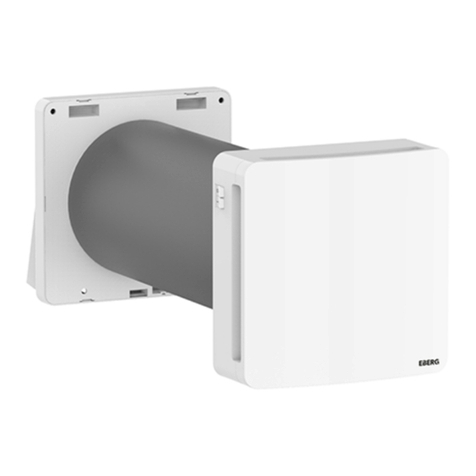
Eberg
Eberg REQU Installation, operation and maintenance manual
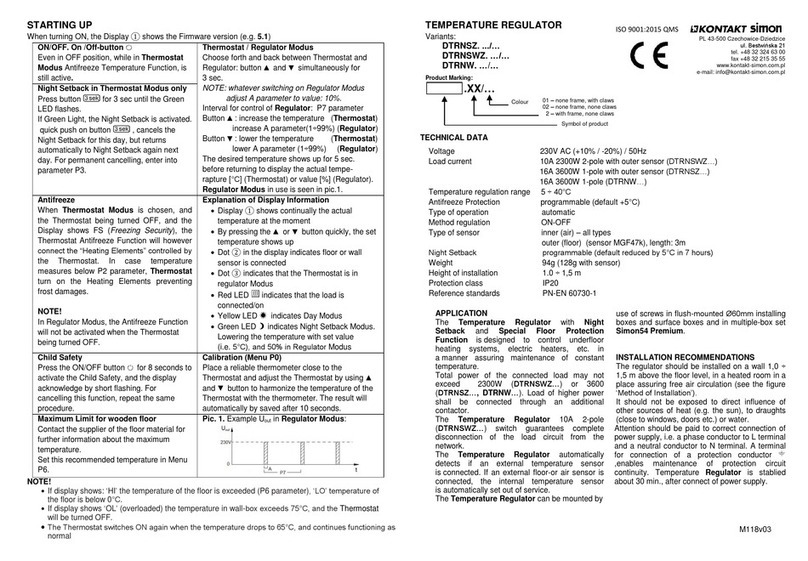
Kontakt Simon
Kontakt Simon DTRNSZ Series manual
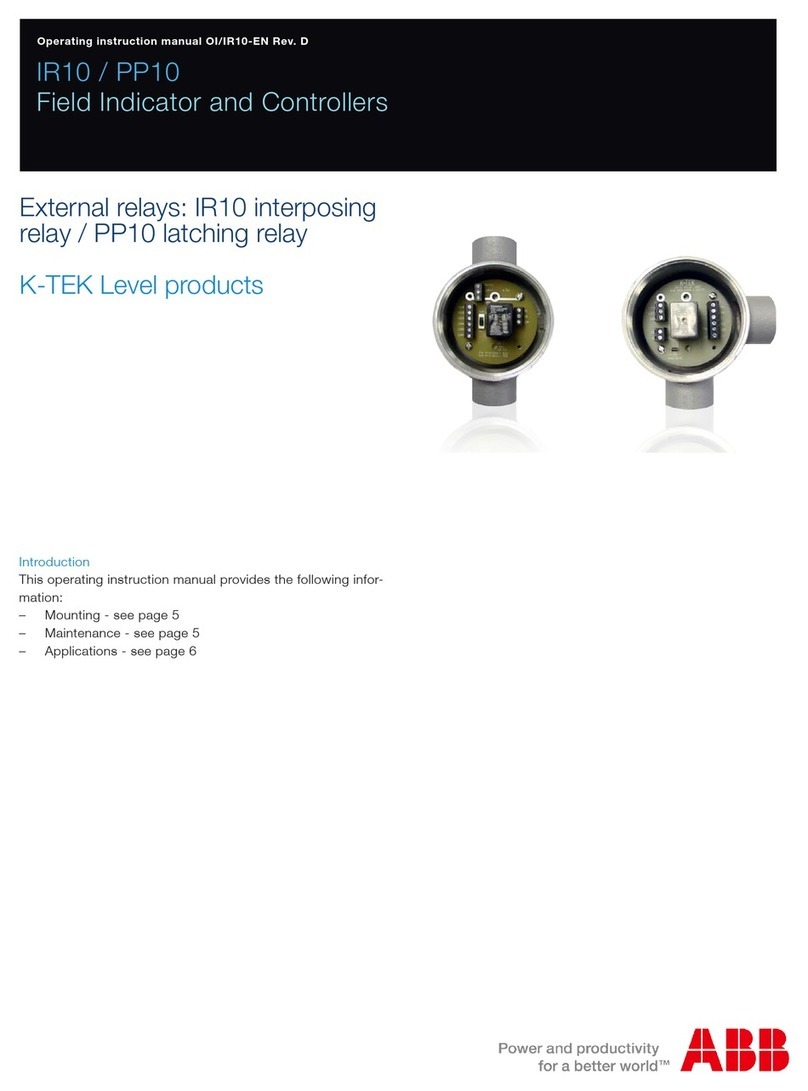
ABB
ABB PP10 Operating instructions manual
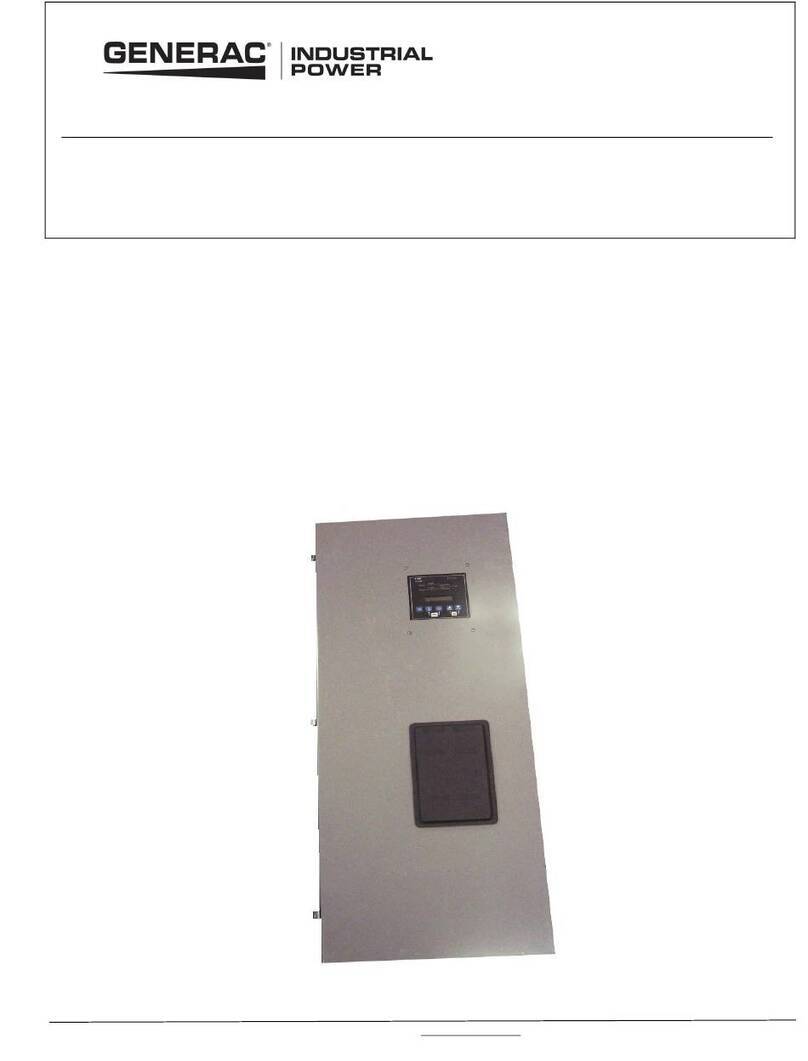
Generac Power Systems
Generac Power Systems ATC-300+ Operation and maintenance manual
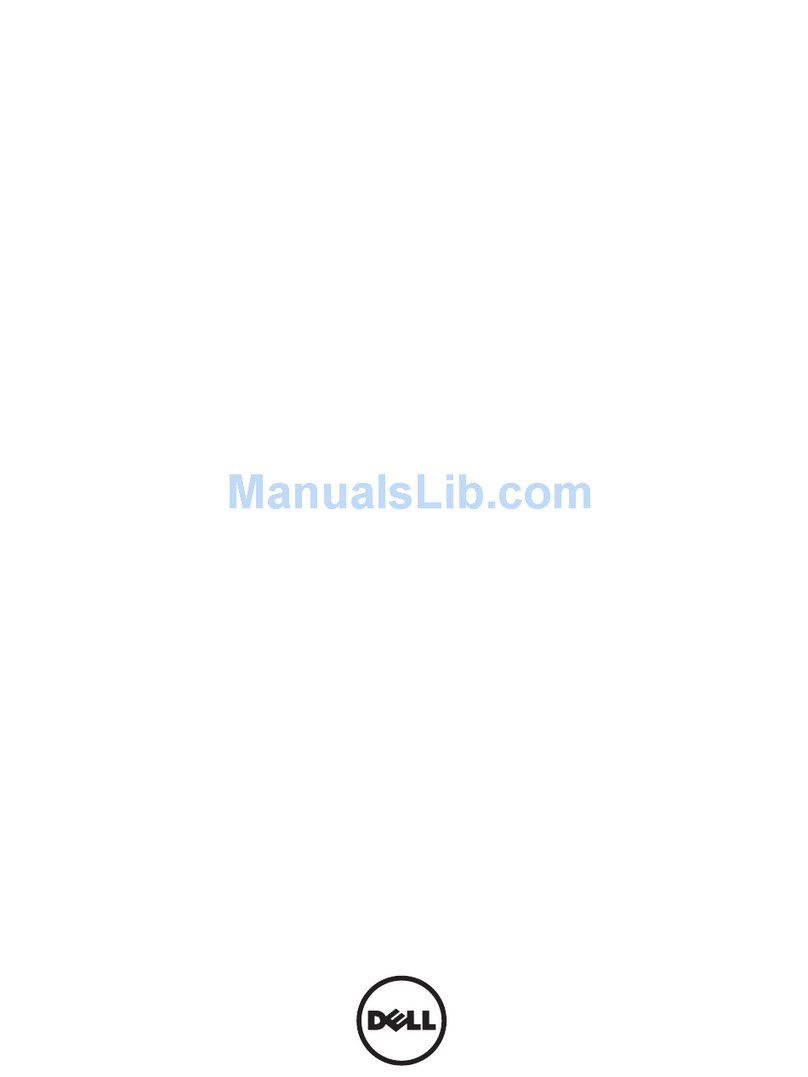
Dell
Dell PowerConnect W-620 installation guide

Dungs
Dungs FRM Series instruction manual
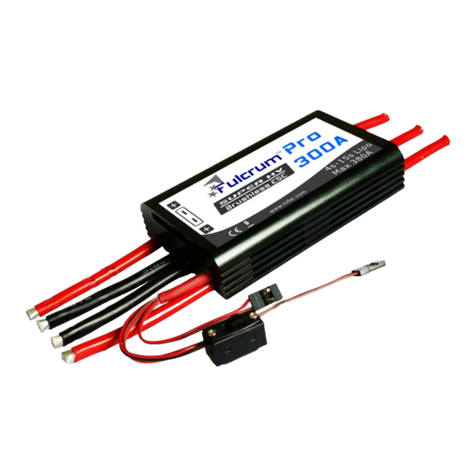
HIFEI Technology
HIFEI Technology Fulcruum PRO Quick setup guide

Kohler
Kohler Dongle 23777T installation instructions
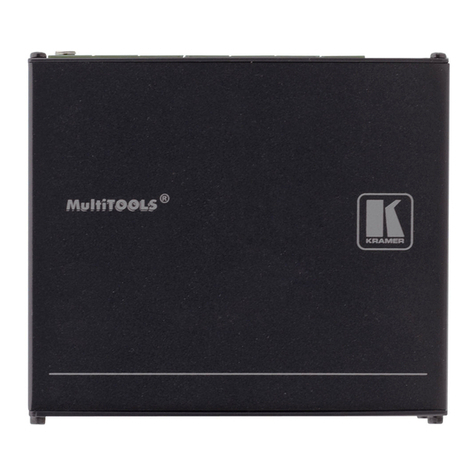
Kramer
Kramer SL-12 user manual
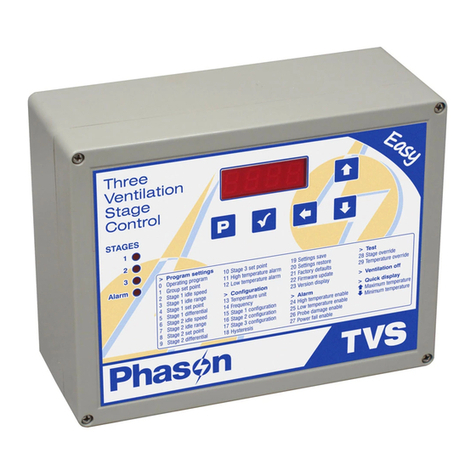
Phason
Phason TVS User manual and installation guide
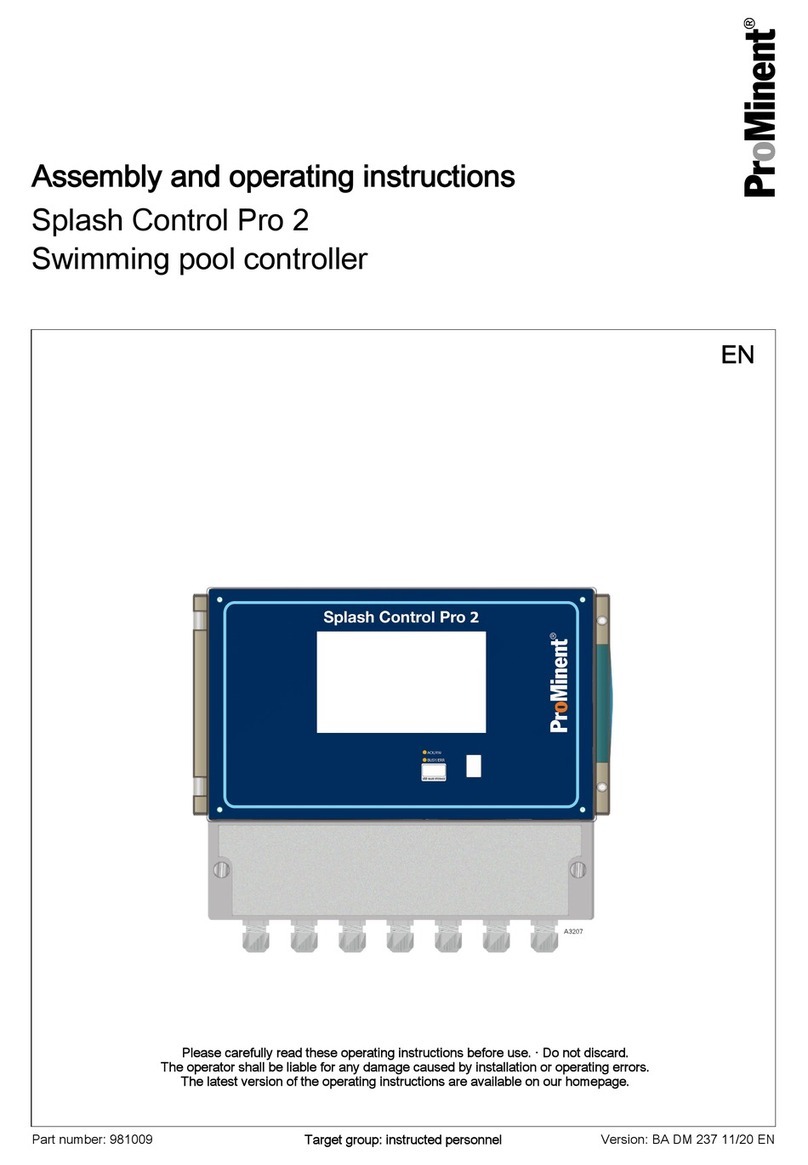
ProMinent
ProMinent Splash Control Pro 2 Assembly and operating instructions
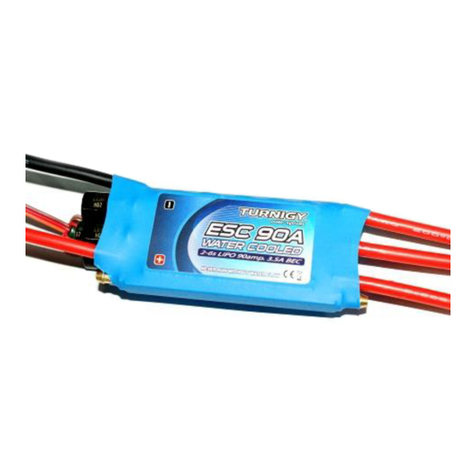
Turnigy
Turnigy Aquastar ESC 120A manual

